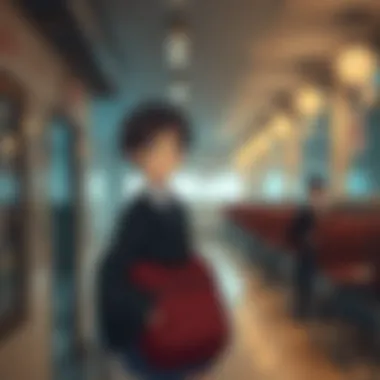Understanding Time Stop in Japanese Anime School Settings


Intro
The theme of time stop carries a unique allure, especially in Japanese school settings, weaving itself through various narratives, particularly in anime. This concept often manifests as a magical or unexpected occurrence, granting characters a pause from their busy lives filled with schoolwork, friendships, and personal dilemmas. The ability to freeze time not only bumps up the excitement in storytelling but also opens many doors for explorations into the psychological and emotional depths of young characters. By examining this intriguing premise, we reflect on the deeply rooted themes of youth, nostalgia, and escapism prevalent in anime culture.
In this setting, time stop can represent much more than just an idle moment; it serves as a powerful metaphor for the struggles and aspirations of youth. School life, often marked by cyclical routines and pressures, stands in stark contrast to the freeing concept of experiencing life at a halt, if only for a moment. The exploration of how this theme affects character growth and audience perception reveals a rich tapestry of layers beneath the surface of simple storytelling.
The impact on viewers, especially the younger audience, resonates deeply with their own experiences of pressure and the desire to escape reality. This article seeks to dissect the various implications of time stop within Japanese school narratives, delving into the psychological aspects that captivate audiences and shaping their overall viewing experiences.
Features of Popular Anime Apks
The rise of digital platforms has made access to anime more convenient, and this shift has birthed various anime-related applications. These apps often serve as the primary gateway for enthusiasts to dive deep into their favorite shows, and some features enhance this experience significantly.
User-Friendly Interface
Anime applications like Crunchyroll and Funimation sport interfaces tailored to keep user experience in mind. Navigation is usually smooth, with categorized genres, easy searching capabilities, and customizable settings that allow users to tailor their preferences. This approach makes it easier for users to find series that explore themes like time stop without sifting through unrelated content.
Compatibility with Multiple Devices
Another attractive component is their wide compatibility across devices. Whether you’re watching on a smartphone, tablet, or smart TV, many of these apps provide seamless transitions. The ability to pick up where you left off enhances the viewing experience dramatically, allowing users to feel involved regardless of where they are.
How to Discover and Engage with Time Stop Theme in Anime
Though the specific aspect of time stop can vary greatly from one series to another, understanding how to discover shows that delve into this theme can deepen appreciation for the narratives.
Exploring Anime Focusing on Time Stop
To pinpoint anime that incorporates time stop, it’s vital to explore various genres. Some common series renowned for utilizing this concept include 'Steins;Gate,' which dives into time travel, and 'The Girl Who Leapt Through Time,' which intricately explores the implications of time manipulation.
Learning from Fan Communities
Engaging with communities on platforms such as Reddit can offer invaluable insights. Channels dedicated to anime often discuss the nuances of storytelling elements like time stop, enhancing understanding of why these themes resonate. Participation in discussions allows fans to share their interpretations and broaden their perspectives on character motivations and story arcs.
Closure
As seen, the notion of time stop stretches far beyond a mere plot device within Japanese school settings. It touches the core of various psychological elements, captivating viewers with its sentiment of longing and escape. By engaging with anime that explores these themes and utilizing digital platforms for easier access, fans can cultivate a deeper appreciation for the storytelling within this cultural phenomenon.
"The stories that involve time stop not only reflect our yearning to escape but also mirror our fears of moving forward in life."
Through understanding and exploring this captivating theme, the relationship between anime and those who consume it deepens, creating a shared experience that fosters connection among fans.
Intro to Time Stop Concepts in Anime
When delving into the world of anime, one encounters a variety of themes that resonate deeply with audiences. Among these themes, the concept of time stop stands out for its rich potential in narrative and character development. Time stop is not merely a gimmick; it encapsulates a blend of escapism, youthful aspirations, and moments of introspection that resonate profoundly in a school setting. By examining how this concept is interwoven with Japanese culture, we can gain insights into the societal reflections that fuel its popularity.
Defining Time Stop
To grasp the idea of time stop, one must first understand what it entails within anime narratives. Time stop occurs when the flow of time is suspended or altered, permitting characters to experience unique moments away from the constraints of reality. This might manifest as a character finding themselves in an unexpected freeze-frame, allowing them to interact with their environment or ponder significant decisions without the passage of time affecting them.
In many instances, it serves as a metaphorical lens through which we view the experiences of Young individuals grappling with academic pressures, social dynamics, and the often tumultuous journey of self-discovery. Characters may use this frozen time not only to escape the hustle and bustle of their daily lives but also to confront their innermost feelings and desires. Consequently, time stop becomes a narrative device that adds layers to character growth and emotional depth.
Historical Context in Japanese Media
The roots of time manipulation in Japanese media can be traced back to early literature and folklore, where time itself often plays a malleable role. Japanese storytelling has long revisited the idea of time distortion, reflecting cultural philosophies such as the fleeting nature of life and the importance of cherishing moments.
For instance, narratives from the Edo period included stories where characters endure experiences that seem to defy time, ultimately leading to moral lessons or revelations. In more contemporary settings, time stop in anime connects with themes prevalent in Japanese society today.
Popular shows like "Naruto" and "The Girl Who Leapt Through Time" illustrate how such themes have evolved. In these stories, the ability to stop time is not just a mere plot device but an exploration of deep-rooted social anxieties concerning youth and societal expectations. This historical context enriches the viewer’s understanding of how time stop is perceived in modern narratives and highlights its adaptability and significance across generations.
The integration of time stop reflects not only an artistic choice but also the collective consciousness of a society that grapples with the pace of modern life. It presents opportunities for young characters to engage in self-reflection amidst the chaos of their surroundings.
"Time stop serves as both a canvas and a mirror, allowing characters to paint their inner conflicts while reflecting societal pressures and personal aspirations."
The Role of Schools in Japanese Culture
In Japan, schools are not merely institutions for education; they hold a profound significance that reflects the cultural values of the society. This is especially true in the context of anime, where school settings often become a backdrop for complex storytelling, character development, and thematic exploration. The role of schools in Japanese culture intertwines education, social interaction, and personal growth, laying the foundation for youth experiences that resonate deeply with audiences. Through the lens of the concept of time stop, this cultural backdrop gains even more depth.
Symbolism of School Settings
School settings in Japanese media symbolize much more than just a place of learning. They represent a microcosm of society, showcasing the everyday lives of students navigating friendships, competition, and personal challenges. The confinement of time stop narratives within a school setting amplifies this symbolism, allowing creators to explore themes of escapism and nostalgia. In stories where time stands still, characters can often reflect on their fears, ambitions, and relationships without the usual pressures of the outside world.


- Schools as reflections of societal norms: They illustrate the expectations placed upon students, serving as a crucible for character development.
- The friend and rivalry dynamics: These elements highlight significant emotional stakes which become even more poignant when time appears to halt, giving audiences a chance to appreciate the depth of characters’ interactions.
- The ephemeral nature of youth: School is often depicted as a fleeting phase, and within time stop themes, this poignancy becomes more pronounced. The technique underscores the harsh reality that these moments, while frozen, cannot last forever.
The blend of school life and the time stop motif creates compelling narratives that resonate with viewers, invoking feelings of nostalgia for their own school years. As time freezes, characters grapple with their youthful dilemmas, enhancing the emotional weight of decisions they make in this liminal space.
Educational Structures and Their Representation
The depiction of educational structures within anime not only serves to ground the narrative but also explores deeper philosophical ideas about learning and social roles. The Japanese school system is defined by rigor, discipline, and a focus on collective participation. In this context, time stop narratives reveal a unique perspective on these societal constructs:
- The critique of educational pressures: The time stop becomes a device through which students can confront the intense expectations placed upon them. In the paused moment, they can reflect on who they are versus who they are expected to be.
- Character development through relatable scenarios: Each student’s experience—be it stress from exams or expectations from family—provides a fertile ground for growth. The time stop lets audiences seeing how characters reach their breakthrough moments.
- Exploration of group dynamics: Schools represent collective experience, and with halted time, audiences might witness the intricate dance of cooperation, competition, and varying perspectives that characterize student interactions.
In summary, the representation of educational structures within Japanese school settings and the intertwining of time stop motifs enriches the narrative canvas of anime, allowing viewers to engage critically with both the medium and the messages it conveys.
"School settings, intertwined with the concept of time stop, serve as powerful backdrops for themes of youth, identity, and societal expectations in Japanese anime."
Through this lens, we can now shift our focus to how time stop themes influence characters psychologically, revealing deeper implications for narratives within Japanese school settings.
Psychological Implications of Time Stop
The theme of time stop in Japanese school settings resonates deeply at the psychological level, influencing both characters and the audience. By exploring this theme, we get a glimpse into the mental and emotional landscapes of individuals�—both within the stories and in real-life perspectives. The significance of this exploration can be summed up in a few core elements:
- Cognitive Reflection: Time stop prompts characters to pause and reflect on their experiences, decisions, and feelings. It often creates a backdrop for critical character development.
- Escapism and Reality: The phenomenon allows for experiences that blur the lines between fantasy and reality, encouraging viewers to contemplate their own lives and struggles.
- Emotional Resonance: Characters frozen in time reflect the viewer's nostalgia, contributing to a multifaceted engagement with the narrative.
Through these elements, the psychological layers of time stop serve as windows into burgeoning emotional understandings, not only for the characters but also for the audience.
Cognitive Effects on Characters
When time is paused or altered, characters in these narratives often navigate a spectrum of cognitive effects that deeply influence their actions and growth. Here are some of the more profound impacts:
- Inner Conflict: Characters are often faced with dilemmas that require introspection. With the external world at a standstill, they confront their internal fears and desires.
- Heightened Awareness: The experience of time freezing can create a moment where characters become acutely aware of their surroundings or their emotional state, leading to pivotal realizations.
- Relationship Dynamics: As time stops, it creates space for unspoken thoughts or feelings between characters, resulting in climactic moments that can shift relationships.
- Growth Opportunities: The time stop mechanism can serve as a narrative device to illustrate how characters evolve through their reflections, leading to growth in both personality and decision-making.
Through these effects, the portrayal of time stop offers a rich canvas that showcases the complexities of human psychology within the context of Japanese school settings.
Viewer Engagement and Interpretation
The engagement of viewers with time stop concepts is marked by a powerful blend of fascination and relatability. As audiences immerse themselves in these narratives, their own experiences can be mirrored through multiple lenses:
- Relatable Escapism: Viewers often long for moments where they can escape their responsibilities. The time stop theme encapsulates this desire, creating a connection with the audience’s own yearning for solace.
- Reflection on Youth: The youth depicted in these stories often reflects the struggles and joys of the viewer's own formative years, heightening emotional engagement.
- Cultural Insights: Different interpretations depend on cultural contexts, influencing how a viewer's background shapes their understanding of the theme.
- Community Reactions: Online discussions, such as those found on platforms like Reddit and Facebook, often dissect these themes, revealing how audiences interpret psychological undertones in diverse ways. This active engagement fosters broader community reflections on the topic.
Consequently, the implications of time stop in Japanese anime resonate beyond the screen, inviting viewers to reflect on their own lives and inviting deeper conversations within cultural communities.
"Time is a concept that can shape our lives more than we realize, and in anime, it's often a gateway for self-discovery."
By examining psychological implications, we gain insights into both character dynamics and audience engagement, enriching the overall understanding of how time stop functions as a compelling narrative element.
Popular Anime Featuring Time Stop Themes
The concept of time stop in anime is not merely a fanciful gimmick; it serves as a unique storytelling mechanism that captures the essence of youth, memory, and the often overwhelming pressures faced by characters in school settings. By incorporating time-stop scenarios, these narratives allow viewers to delve into the intricacies of their experiences and emotions. Notably, the anime that tackle this theme often generate rich discussions around character development, moral dilemmas, and the psychological underpinnings of their youthful protagonists.
Case Study: Notable Examples
When you look at anime that feature time stop, a few titles stand out due to their distinct approaches and the impact they leave on audiences. Here are some examples:
- Steins;Gate: Though primarily about time travel, it often portrays characters experiencing time moments in vastly different ways, giving the illusion of a time stop while impacting their decisions dramatically.
- The Girl Who Leapt Through Time: This film showcases a young girl who discovers she can leap through time, creating a form of time stop as she alters events to achieve her desired outcomes. This leads to a slew of unforeseen consequences that resonate with the typical school experience of trying to navigate life and relationships.
- Re:Zero - Starting Life in Another World: In this series, the protagonist has the chance to reset time upon death, presenting a literal perspective on time stop that emphasizes choices and consequences. Here, every reset serves as a heart-wrenching opportunity to correct mistakes but also highlights the emotional toll such power carries.
Each of these examples highlights not just the mechanic of stopping time, but also how it can shape the viewer's understanding of pivotal moments in adolescence.
Analyzing Character Dynamics Within These Narratives
Understanding the character dynamics within these time stop narratives presents a fascinating glimpse into how relationships evolve when the characters possess unique temporal abilities. For instance, in Steins;Gate, the way the characters react to altered timelines showcases their growth and emotional depth. Time becomes a tangible force that they wrestle with, reflecting their fears and desires.
Moreover, the emotional stakes in The Girl Who Leapt Through Time are incredibly pronounced. The protagonist grapples with her newfound abilities, wrestling with the implications of her choices on others’ lives. In the context of a school setting, this becomes a powerful metaphor for the challenges faced by young people making critical decisions about friendships and love.
Examining these dynamics reveals that the visibility of time—whether halted, reversed, or altered—forces characters to confront their relationships with others. In Re:Zero, for example, the protagonist's resets not only affect him but alter how other characters perceive him, showcasing varying layers of attachment and support.
In essence, these anime portray how time manipulation reveals the fragility of human connections, emphasizing that even in a seemingly controlled environment, relationships can change in an instant—or, conversely, remain unchanged while the world shifts around them.
The exploration of time stop in popular anime serves to illuminate the often tumultuous journey of youth, portraying emotional depth through the manipulation of time.
The intricate storytelling and character dynamics in these series delve into what it means to grow up, the burdens of choice, and the essence of time itself, making them integral to understanding the broader implications of this theme in Japanese media.


Cultural Reflections of Time Stop Concepts
The concept of a time stop is not just a whimsical fantasy in anime; it serves as a profound reflection of cultural themes and societal sentiments in Japan. The theme resonates strongly with modern youth, tapping into their aspirations, fears, and nostalgic longings. No doubt, examining how time stop motifs resonate in Japanese society sheds light on the broader implications of these narratives.
Influence on Modern Japanese Youth
When exploring how time stop narratives shape modern Japanese youth, one can't ignore the pressures they face from numerous fronts—academic expectations, societal norms, and familial duties. The concept taps into a longing for relief from these towering expectations, creating a parallel world where time itself can be paused.
Imagine a high school student who's overwhelmed with studying for exams or juggling multiple clubs. The idea that time could halt, permitting a moment to breathe or reassess life, holds a substantial appeal. Characters in these anime often embody this yearning, creating a disconnection between real-life responsibilities and desired escapism.
In many popular series, moments of time stop allow characters to genuinely reflect on their lives, express unspoken feelings, or even confront fears. This reflection can resonate strongly with viewers as they may find themselves wishing for moments in reality where they could also hit pause and take stock of their circumstances.
Nostalgia and Its Impact on Narrative Structures
Nostalgia plays a crucial role in framing the narrative around time stop. Within the youth-oriented contexts of Japanese schools, these themes evoke a longing for simpler times, whether it’s the carefree days of childhood or foundational experiences that molded their identities.
In anime, characters often find themselves revisiting moments of their past, whether through flashbacks or the literal stopping of time, which highlights significant events in their lives. This facility of time manipulation allows viewers to indulge in their own musings and reminiscences, making the entire experience deeply personal.
Many narratives blend nostalgia with the time stop motif to underscore a universal truth: the struggle against the relentless march of time. Honorably, it explores the symbolic nature of youth, providing insight into not just individual experiences but examining societal values as well.
“In the realm of time, all things falter, but memories persist.”
Time stop moments often feature in scenes laden with emotional weight—confessions of love, farewells, or transitions from one life stage to another. These scenarios can rouse feelings of nostalgia within the viewers, drawing them into a murky yet comforting space of longing, thus enriching the narrative.
Thus, cultural reflections in time stop narratives can be seen as not only tools for story progression but also as mirrors that echo the collective consciousness of modern youth in Japan—addressing their desires, struggles, and the inevitable passage of time that so deeply affects all lives.
For a deeper dive into the essence of nostalgia in narratives, check resources such as Wikipedia or Britannica.
Technical Aspects in Animation and Storytelling
The concept of time stop in Japanese school settings sheds light on both animation techniques and narrative storytelling. This dual focus is crucial, as it highlights how visuals intertwine with storytelling to craft a rich tapestry that resonates with viewers. Understanding the technical aspects can elucidate why such a concept captivates audiences, especially in anime, where imagination meets intricate detail.
Animating a time stop moment is not just about freezing frames. It involves clever techniques to convey the experience of stasis in a world of movement. Several factors come into play, from pacing to visual storytelling cues. Proper execution allows the audience to feel the weight of time standing still. This creates a sense of tension, urgency, or even contemplation. When done effectively, it can lend depth to themes of youth and nostalgia.
Moreover, the technical elements often dovetail with the emotional undercurrents of the story. They set the mood, dictate the narrative’s rhythm, and help frame characters' emotional arcs. The synergy between storytelling and animation enhances viewer engagement, leading to more profound interpretations of the time stop theme.
Animation Techniques for Depicting Time Stop
In crafting scenes where time ceases to flow, animators employ several techniques:
- Frame Freezing: This is the simplest method, where a specific frame is held to convey that time has stopped. However, the art lies in the context—what happens around this frozen moment? Conjuring creative transitions in and out of this freeze can spice up narratives.
- Motion Blur: When characters or objects that are moving become blurred just before the moment of time stopping can create a visual contrast. This illustrates the sudden cessations of motion, improving the impact of the freeze.
- Slow Motion: Utilizing slow-motion effects just prior to a time stop can heighten anticipation. The gradual deceleration familiarizes viewers with the pacing, so when the time stop occurs, its effect is amplified.
- Color Palette Changes: Switching the color scheme during time stops can signal to viewers that the sensation of normalcy has been disrupted. For instance, using cooler colors might evoke a sense of eeriness, while warmer tones might inspire nostalgia.
These methods must be carefully integrated into both the visual narrative and the storyline, ensuring that they contribute meaningfully to the overarching themes.
Narrative Techniques in Storytelling
The narrative surrounding time stops in anime is layered intricately with symbolism and thematic connections. Different storytelling approaches often enrich the experience:
- Foreshadowing: Prior hints or visual cues can prelude a time stop scenario, enhancing emotional weight. This builds anticipation and prepares the audience for the narrative shift.
- Character Reflections: Allowing characters to reflect on their choices or feelings during time stop moments adds depth. Such introspection can reveal insights into their personalities and motivations.
- Non-linear Storytelling: Introducing non-linear narratives can enhance the impact of time manipulation. Jumping between timelines can showcase contrasting perspectives and highlight the consequences of actions taken before and after a time stop.
- Comparative Juxtaposition: Placing side-by-side moments of stillness against the chaos of time moving forward can create poignant contrasts. It’s a relatable way to explore themes of adolescence, change, and growth in a school setting.
By utilizing these narrative techniques, creators not only tell stories but also evoke profound psychological responses from their audience, creating legacies that resonate long after the screen fades to black.
"Time stops for no one, but within the realm of animation, it can bring forth epiphanies that define the human condition."
In summary, exploring the technical aspects in animation and storytelling reveals a sophisticated interplay of techniques that elevate the time stop concept. These methods, adding layers of meaning and emotional engagement, can deepen viewers' connections to the characters, ultimately enriching their anime experience.
Viewer Reception and Critique
Understanding viewer reception and critique of time stop elements is critical in analyzing their impact on anime narratives set in school environments. This section explores how audiences engage with these themes and the varying interpretations that emerge from community discussions.
Audience Reactions to Time Stop Elements
Time stop concepts often elicit a spectrum of reactions from viewers. For some, the appeal lies in the fantasy of escaping the pressures of time, a theme that resonates deeply with students navigating their own lives in a fast-paced academic environment. This concept can serve as a metaphor for freedom, allowing characters to explore uncharted territories on an emotional and cognitive level, even while their physical circumstances remain frozen.
Moreover, reactions are shaped by personal experiences. Viewers might see themselves reflected in these characters, sparking discussions around shared desires for pause or reflection in their busy lives.
On platforms like Reddit, threads dedicated to specific anime frequently reveal the nuances of audience reactions. It's common to see individuals expressing how certain time stop scenes evoked nostalgic feelings or facilitated deeper emotional connections with characters. Contrastingly, there are critiques questioning the reliance on this plot device; some argue it can dilute character development or overly simplify complex themes. The divide showcases the richness of viewer engagement with such narratives, as preferences vary widely.
Critical Analysis of Themes in Community Discussions


The community discussions surrounding time stop themes provide an engaging glimpse into viewer sentiments and interpretations. Online forums, such as those hosted by anime enthusiasts on sites like Facebook or dedicated subreddits, serve as melting pots of ideas, interpretations, and critiques. Participants often delve into how time stop moments reflect larger societal constructs within Japanese culture, such as the academic pressures faced by youth.
Discussions may center on whether these narratives glorify escapism or foster a more profound understanding of the realities faced by students. A key point often raised is that while time stop sequences grant moments of reflection and freedom, they can sometimes mask the underlying issues of stress and anxiety prevalent among the younger generation.
"The more we talk about it, the clearer it becomes that time stop elements are not just narrative devices, but mirrors reflecting our societal values and pressures."
Critics also highlight how the portrayal of time pauses can either enrich or hinder storytelling. Engaging discussions might critique specific shows where this concept feels shoehorned in, contrasted against those where it feels integral to character growth and plot development.
These exchanges not only deepen fans' appreciation for anime but also encourage critical thinking about narrative techniques. In summary, the reactions to time stop elements, coupled with community critiques, help illustrate the complexity surrounding this theme in Japanese school settings, enhancing our overall understanding of its cultural significance.
Comparative Analysis with Western Media
Analyzing time stop themes in Japanese anime provides an enriching avenue to understand distinctive cultural expressions, especially when compared with Western portrayals. This comparative analysis is crucial to discerning how each region processes the concept of pausing time within its storytelling frameworks. Japanese media often employs the time stop concept to evoke nostalgia and introspection, particularly in school settings. In contrast, Western narratives tend to frame such moments within action-driven plots, highlighting the urgency and consequences of time manipulation.
Differences in Interpretation and Representation
In Japanese anime, time stop typically serves as a means for characters to reflect on their relationships, foster deep emotional connections, or confront personal dilemmas. This approach contrasts sharply with the Western interpretation, where time manipulation is often a device for activating heightened drama or comedic scenarios. For instance, in anime like Kimi no Na wa (Your Name), the concept of time is almost sacred; it intertwines with themes of destiny and love, compelling the viewer to engage with deeper existential questions about connection and memory.
On the other hand, shows like The Flash in the West utilize time manipulation as a plot device to create action-packed sequences, where the stakes often revolve around defeating villains or preventing catastrophe. Characters act with immediacy, focusing on external conflicts instead of the internal struggles that typically characterize Japanese narratives. This emphasizes the contrasting cultural values at play—Japanese narratives often celebrating introspection, while Western narratives hone in on action-oriented themes.
Insights into Cultural Nuances
Understanding the differences in how time stop is portrayed in Japanese and Western media offers invaluable insights into the cultural nuances that shape storytelling. In Japan, schools symbolize a critical period of emotional growth and self-discovery for youths. The time stop not only reflects a desire to linger in those formative moments but also allows characters to process their experiences fully. It aligns with societal values that cherish memories and relationships, providing a layer of relatability for viewers.
In contrast, Western media often presents schools as backdrops for conflict or comedic situations, with less emphasis on the emotional developments occurring within those walls. This difference speaks to broader cultural narratives—where Japanese society often idealizes youth and seeks to capture its transience, Western narratives frequently focus on the progression towards adulthood and the resolutions of conflicts.
"The portrayal of time stop, from Japanese anime to Western films, shows not just a variety of storytelling techniques but also the intricate tapestry of cultural beliefs and values."
This analysis reveals that time stop themes are more than mere plot devices; they reflect the cultures from which they emerge. By bridging the gap between Eastern and Western interpretations, we gain a comprehensive understanding of how narratives shape and are shaped by societal values, ultimately enriching the overall dialogue about time in media.
Future Trends in Time Stop Narratives
As we move forward in the realm of anime and storytelling, the concept of time stop is evolving. This transformation holds significant weight in understanding the cultural and artistic implications it carries in contemporary narratives. The increasing complexity and depth of characters are emerging as key components in depictions of time dilation.
Evolving Themes in New Releases
Recent anime uncover a fresh take on the time stop theme, often integrating it with elements of self-discovery and personal growth. Unlike earlier portrayals which merely featured suspension of time, modern narratives are embracing the idea of characters using this phenomenon as a metaphor for their insecurities or unresolved issues.
Some new titles include:
- "Re:Zero - Starting Life in Another World": Here, the protagonist finds himself trapped in a time loop, highlighting the impact of repeated failures on his psyche. It serves to illustrate the struggles of facing one’s fears.
- "The Girl Who Leapt Through Time": This film employs time travel as a means for the lead to reflect on her life choices and relationships, offering viewers a deeper emotional journey.
Incorporating sophisticated themes within a school setting engages the audience on multiple levels, making the narratives relatable and thought-provoking.
Anticipating Viewer Expectations
As anime continues to gain popularity globally, the sophistication of storytelling must match the expectations of a discerning audience. Viewers are no longer satisfied with simple tales; they desire depth, layers of meaning, and character arcs that resonate beyond the screen.
With the rise of online communities, feedback loops are tightening, enabling creators to adapt themes in response to audience reception. For instance, in recent discussions on platforms like reddit, fans express a desire for more nuanced portrayals of time stop — not merely as a narrative device but as a catalyst for character evolution.
Anticipating viewer expectations hinges on:
- Innovative Storylines: Creators are exploring unconventional narratives that challenge traditional storytelling in animation.
- Cultural Reflections: Themes must reflect modern societal issues, serving as a channel for conversations around youth pressures and mental health.
- Audience Participation: Engaging viewers, allowing them to contribute creatively through forums or co-creation platforms reinforces the community aspect of anime fandom.
In essence, the trajectory of time stop narratives in anime is heading towards more complex layers that reflect the intricate nature of life itself. It's a delicate dance between tradition and innovation, ensuring viewers remain intrigued while encouraging an emotional connection with the story.
Finale: The Broader Significance of Time Stop in Anime
The concept of time stop in anime, particularly within Japanese school settings, holds a special place in both storytelling and cultural discourse. It serves not only as a narrative device but also as a reflection of societal perceptions regarding youth, individuality, and time itself. In this conclusion, we will untangle the multifaceted implications that this theme carries, resonating across generations of fans and creators alike.
Final Reflections on the Theme
Time stop narratives often present a poignant metaphor for the fleeting nature of youth. Characters find themselves pausing in moments that define their lives, allowing the audience to wrestle with their own nostalgia. This thematic element speaks volumes about the universal desire to freeze time during significant life phases. Take for example the anime "Your Name," where time and fate intertwine, revealing how interconnected lives can be altered in a moment. Such stories not only engage viewers but also compel them to confront their own transformations, making it clear that these narratives extend beyond mere fantasy.
Furthermore, the emotional undertones embedded in time stop sequences add layers of depth to character developments. For instance, when a character faces the trajectory of their future, often paralleled by a sudden halt in time, it generates a space for introspection.
Implications for Anime Culture and Audiences
The embedding of time stop in anime culture translates to significant implications for audiences, inviting them to explore their connection to these narratives. Through the lens of escapism, viewers experience a yearning for control over their circumstances, particularly in the face of the pressures associated with adolescence and adult responsibilities.
- Cultural Critique: Many series using this motif present critiques of the educational system and societal expectations, highlighting struggles of modern youth.
- Audience Engagement: By inviting audiences to experience a shared stagnation with the characters, the emotional stakes intensify, reinforcing connections and fostering community discussions.
The popularity of this theme can also be tied to the rise of digital online forums, where fans dissect and debate its meaning in a space that encourages varied interpretations. Platforms such as Reddit enable deep dives into these themes, where collective insights contribute to a richer understanding of the shared cultural touchstones.
Time stop not only enables audiences to reflect on their lives but also encourages creators to push boundaries in storytelling. As these narratives continue evolving, one must wonder how future generations will perceive this complex interplay of time, youth, and emotion. As anime continues to develop, the significance of the time stop concept remains, persistently invoking thought, nostalgia, and a nuanced understanding of one's own journey through life.
“For a moment, we can change everything; for a moment, we can just be.”















